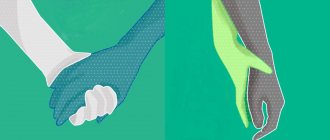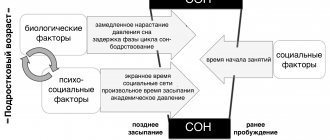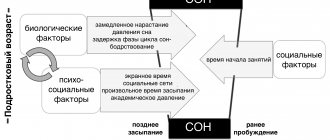There are many different causes of trembling in the hands, and it is very important for a person to distinguish what and why this trembling is caused. In some cases, trembling hands is normal, in others it may indicate the development of some disease. If you notice that you have hands are shaking, you should monitor your symptoms and consult a doctor.
Tremors or shaking are rhythmic and fairly rapid movements of the limbs or the entire body that are caused by muscle contractions. It is worth noting that doctors distinguish two types of tremor - normal and pathological. Depending on the type of tremor, a diagnosis is made and subsequent treatment is prescribed.
Types of hand tremors
Tremors are classified according to the cause of their occurrence:
- physiological (hand vibrations inherent in every person, not causing concern, often provoked by stress, anxiety, giving up bad habits, diseases with similar symptoms)
- essential (tremor, indicating disturbances in the functioning of the nervous system, often at the genetic level, usually mild, but quite noticeable, possibly causing inconvenience when writing)
- cerebellar (caused by lesions of the cerebellum, one of the symptoms of multiple sclerosis - replacement of nervous tissue with connective tissue in different parts of the central nervous system)
- secondary (side effect of a drug, symptom of another disease)
There is a classification of the disease according to the time of occurrence:
- resting tremor, occurs when there is no movement
- action tremor associated with hand movements
Muscle stiffness
Muscle stiffness and increased tone are also among the main symptoms of Parkinson's disease. This symptom even has its own term - plastic waxy flexibility. It is characterized by the fact that the limbs and body freeze in a given position. In this case, certain muscles suffer, and their stiffness leads to the formation of the so-called supplicant pose. The person slouches, his head leans forward, his arms are slightly bent at the elbow joints and pressed against the body, and his legs are bent at the hip and knee joints. If an outsider tries to straighten the patient’s limb, he will feel the kind of stepwise movements that are characteristic of gears in mechanisms. The phenomenon also got its name - the cogwheel symptom. Muscles lose the ability to return to their original position after performing an action. Therefore, patients may freeze in different positions for some time.
Causes of hand tremors
There are enough types of the disease being studied, but the causes can be combined:
- chronic fatigue
- lifting heavy objects
- side effect of medications
- blood sugar problems
- hormonal imbalance
- depression, anxiety, worries
- bad habits (smoking, alcohol, drugs)
- stroke, multiple sclerosis, Parkinson's disease, traumatic brain injury, etc.
Sources
- Trufanov E. A. Differential differences in tremor in Parkinson’s disease and essential tremor // Bulletin of new medical technologies. Electronic edition. 2013. No. 1.
- Bashkatova Yu.V., Karpin V.A., Popov Yu.M., Rassadina Yu.V., Shilyaeva O.S. Assessment of the state of parameters of the neuromuscular cluster under conditions of dosed physical activity // Bulletin of new medical technologies. Electronic edition. 2014. No. 1.
- Eshimova Sh.K., Khakimova S.Z., Djurabekova A.T. Evaluation of the effectiveness of anti-tremor drugs in patients with essential tremor // Innovative science. 2016. No. 1-3 (13).
Doctor who treats tremors
Most often, a neurologist will help solve this problem, since in most cases hand tremors are caused by disturbances in the functioning of the central nervous system. Qualified, experienced doctors at the Kuntsevo Medical and Rehabilitation Center will competently select a course of treatment suitable for different cases of hand tremors. Thanks to our center’s own diagnostic facilities (MRI, ultrasound, Electroneuromyography, etc.), the patient will be able to see doctors and begin recovery immediately, which is important for any disease.
IMPORTANT! Hand tremors are a neurological problem that requires intervention by a qualified professional. Self-medication of tremor will not lead to a successful result; moreover, you can worsen your own condition, because the patient does not know at what level of functioning of the nervous system the “error” occurred.
Therefore, make an appointment with a neurologist at the Kuntsevo Treatment and Rehabilitation Center, who, thanks to his own experience, the wide diagnostic capabilities of our center, prescribing the correct treatment tactics and rehabilitation program, will help you eliminate the causes of hand tremors.
Sign up
Varieties
Weakness and trembling in the hands can occur both at rest and during physical activity. It is divided into low-, medium- and high-amplitude, depending on the severity of the tremor. If tremor of the fingers is the only symptom, it is called isolated; if not, it is called combined.
Hand tremors can affect other parts of the body. In this regard, its varieties are distinguished:
- focal - only hands, head, jaw tremble;
- segmental - trembling of several adjacent parts of the body is observed;
- hemitremor - trembling is observed on one side of the body - for example, the right or left hand, including the fingers;
- generalized - head, arms, legs, tongue shakes.
Tremor can be mild, moderate, significant or severe. Classification is important in diagnosis, as it allows one to assess the location and extent of damage to the nervous system.
Treatment methods
With cerebellar tremor, it is recommended to load the affected limb with weight, and medications will not help in this situation.
Physiological tremor, which does not cause concern, does not require treatment, you just need to avoid the supposed pathogens (caffeine, alcohol, anxiety). In case of inconvenience and the need for treatment, the use of propranolol in a dose of 20 to 80 mg 4 times a day will be effective.
Essential tremor can be treated with the same medications that can be used for irritating physiological tremor; another option is to take a small amount of alcohol, but this method is used occasionally due to the risk of abuse.
Parkinson's disease is treatable, and levodopa (a metabolic precursor of dopamine) is a drug that combats this disease.
Thus, drug treatment is widely used for types of hand tremor other than cerebellar, and physiological tremor in most cases will be stopped by consultation with a neurologist.
The Kuntsevo Treatment and Rehabilitation Center uses SMT therapy, also known as electrotherapy, which affects the nervous system and muscles. All treatment procedures are carried out by experienced specialists, and the technical equipment meets international quality standards.
The following procedures will help solve problems with the nervous system: drug therapy, manual therapy, massage, acupuncture, electropuncture, laser treatment, ultrasound therapy.
Diagnostics
The cause of hand tremors can be identified based on the results of a comprehensive examination. At the initial stage, a neurologist correlates clinical symptoms with diagnostic criteria and makes a preliminary conclusion, but it is almost impossible to determine the source of disorders without additional research. For trembling hyperkinesis, the following procedures are recommended:
- Laboratory tests.
To exclude endocrine diseases, a spectrum of hormones (thyroid, corticosteroids, insulin) is examined. In a biochemical blood test, renal tests (urea, creatinine), acute phase indicators, and ceruloplasmin concentration are assessed. Toxicological examination helps to identify harmful substances; in case of neuroinfections, serological diagnostics and cerebrospinal fluid analysis are performed. - Tomography.
Signs of focal or diffuse damage to the central nervous system are an indication for performing a CT or MRI of the brain. Neuroimaging methods are used to diagnose tumors, hematomas, and strokes. In hereditary diseases, cerebellar atrophy and demyelination of the white matter are determined. PET-CT indicates the localization of functional disorders. Vascular involvement is confirmed by MR angiography. - Tremorography.
To assess the activity of antagonist muscles, tremorography with accelerometric or electromyographic recording methods is used. According to EMG data, the frequency and pattern of contractions, the influence of cognitive load are determined, and the presence of a central oscillator is assumed. A neuromuscular conduction block indicates the presence of neuropathy.
Some authors propose to study the time-frequency properties of EEG signals to diagnose the early stages of Parkinson's disease. In case of endocrine pathology, ultrasound of the thyroid gland and adrenal glands is prescribed; displacement of the midline structures during volumetric processes can be seen using echoencephalography. The doctor has to differentiate between various diseases accompanied by tremor, and distinguish it from other hyperkinesis.
Recommended Lifestyle
At the moment there are no specific methods of prevention. General recommendations include a healthy lifestyle, proper nutrition, regular preventive examinations with a doctor - all this will help get rid of the annoying disease forever.
So, there are several types of hand tremors, but each of them can be overcome with the help of competent treatment, which is provided by the Kuntsevo Treatment and Rehabilitation Center. In order for rehabilitation to proceed quickly, you must follow the doctor’s instructions and lead a healthy lifestyle.
Hypokinesia
Hypokinesia is a decrease in motor activity. General stiffness of movements is characteristic. In order to make any gesture, the patient must make an effort. Outwardly, it looks as if the movements are made after a pause, they are slow.
A person's gait changes. He moves in small mincing steps, with his feet parallel to each other. The arms do not move in time with the walking, but are pressed to the body. Facial expressions suffer. The face becomes motionless and impassive. The display of emotional reactions is delayed. Such people rarely even blink. The voice changes, it becomes monotonous and dull. If a person utters a long sentence or phrase, it fades towards the end.
Literature:
- A manual on narcology for doctors and paramedics of primary medical care / A. A. Churkin, T. V. Klimenko. - Moscow ; Khanty-Mansiysk: Health and Society, 2006 (Cheboksary: IPK Chuvashia). — 173 p.
- Causes of development and clinical manifestations of alcohol disorders and drug addiction: educational manual / Yu. N. Novichkova; National Health Institution “Scientific Clinical, Center for Postgraduate and Professional Education, Department of Additional Professional Education of Secondary and Junior Medical Personnel. - Moscow: Max Press, 2022. - 81 p.
- Dangerous and harmful alcohol consumption: identification, prevalence and consequences / edited by S. L. Plavinsky, A. N. Barinova. — St. Petersburg: Eco-Vector, 2022. — 287 p.
The text was checked by medical experts: Head of the socio-psychological service of the Alkoklinik MC, psychiatrist-narcologist L.A. Serova.
CAN'T FIND THE ANSWER?
Consult a specialist
Or call: +7 (495) 798-30-80
Call! We work around the clock!
What can you do at home?
In the very initial phases, the appearance of this symptom can be eliminated independently at home. To do this, it is enough to use the simplest methods of help. Let's figure out how to treat tremors on your own without harm to health.
The following measures can help relieve tremors:
- First of all, stop drinking alcohol.
- Sleep well.
- Drink soothing infusions or tablets of motherwort, St. John's wort, valerian, passionflower.
If there has been a binge that the patient is able to cope with on his own, then it is necessary:
- Drink the last small dose of alcohol.
- Eat warm vegetable soup with cream.
- Take a bath and add a liter of apple cider vinegar.
- Then make tea with thyme infusion. The microelements and vitamins it contains have a restorative effect on the neurohormonal system and stabilize the content of neurotransmitters in the body.
- When thirst appears, eat a few pickles or drink brine (cucumber or cabbage).
- Take honey for 3 days in a row. In the morning, 6 teaspoons on an empty stomach, washed down with apple cider vinegar. On the first day, repeat before lunch, 3 spoons at night.
- The following days, only morning honey therapy is enough.
Additionally, multivitamins containing group A, B, C are recommended. Drink adsorbents (activated carbon) at night. Usually these measures are enough for the tremor to completely go away after 3-4 days. If there is no improvement, you should definitely see a doctor and undergo treatment in a hospital setting. This must be done the sooner the better.
How to get rid of the disease
Alcohol tremors indicate a severe form of addiction. Therefore, it is important not only to eliminate the symptoms of the pathology, but also its cause.
Treatment at home with a doctor's call
To eliminate involuntary muscle contractions and avoid progression of the disorder to a generalized seizure, use:
- saline solutions, cocarboxylase, glucose;
- vitamins (necessarily thiamine, pyridoxine and cyanocobalamin);
- hepatoprotectors;
- means for activating cerebral and peripheral blood circulation, nootropic drugs;
- cardioprotectors;
- painkillers and antispasmodics.
Usually such treatment is sufficient to alleviate the patient's condition. If the tremor persists, the patient is additionally administered drugs from the group of benzodiazepines. They have a double effect: sedative and anticonvulsant.
Inpatient therapy
In any case, it is better to carry out detoxification in a clinical setting, but strict indications for hospitalization are:
- chronic diseases of the cardiovascular system;
- renal and/or liver failure;
- severe neurological pathologies (epilepsy, encephalopathy, recent stroke, history of neuroinfections, traumatic brain injuries);
- risk of developing a generalized seizure;
- signs of delirium, hallucinosis;
- use (in addition to alcohol) of drugs, strong sedatives.
In a hospital, the doctor has more opportunities to resolve the issue than to treat alcoholic tremors. The patient is under medical supervision at all times, basic vital parameters are monitored, and medications are administered almost around the clock.
In addition to medications, the clinic offers hardware detox procedures (ILBI, plasmapheresis). Excellent results are demonstrated by physiotherapy, laser or electromagnetic stimulation of biologically active zones on the body.
In a hospital, you can determine and how to treat the cause of alcoholic tremors - an uncontrollable desire to drink. After detoxification is completed, consultations with a psychotherapist begin, who motivates the patient to finally get rid of addiction.
How to treat the disease yourself
Doctors categorically warn against self-medication, taking any medications (and especially sedatives or anticonvulsants) without prior diagnosis and doctor’s prescriptions. But if for some reason the patient cannot go to a specialized hospital, doctors give several tips on how to alleviate their condition:
- completely eliminate alcohol;
- reconsider your diet and diet: you need to give up coffee, strong tea, and energy drinks;
- moderate physical activity is required (but not before bedtime);
- drink plenty of fluids (at least 1.5 liters of clean water per day);
- go to bed on time, before going to bed, avoid watching gadgets and movies - it is better to replace them with a walk in the fresh air.
But these are only temporary measures; final recovery from alcoholism requires complex long-term treatment and mandatory rehabilitation. But in parallel with addiction therapy, to eliminate alcoholic tremors, correction of concomitant neurological and metabolic disorders is also carried out.
Postural instability
Violation of postural fixation can occur in the early stages, for example, patients cannot hold their arms extended forward. But these are not such serious deviations that both patients and doctors pay attention to them. But closer to the later stages of the disease, serious problems begin. For example, there are difficulties with starting movement and stopping it, no matter how difficult it is to overcome the inertia of rest and movement. During movement, the body tilts along the course of inertia; in particular, when moving forward, it tilts and, as it were, moves ahead of the legs. This disrupts the center of gravity and leads to frequent falls and injuries.
What causes tremors in alcoholics
The main reason for this complaint is chronic ethanol intoxication. Alcohol, being a neurotoxic poison, has a direct damaging effect on the cells of the brain and spinal cord, as well as the peripheral and autonomic parts of the nervous system. Ethanol metabolites, in particular toxic acetaldehyde, also have a destructive effect.
As a result, the patient suffers:
- Cognitive-mnestic function (mental abilities).
- Coordination of movements, balance and gait.
- Innervation of muscles.
These manifestations are aggravated by metabolic disorders, hormonal-vegetative imbalance, hypovitaminosis and other consequences of regular alcoholism. Patients experience significant discomfort from the problem and try to find out how to cure the existing pathology.










